ICT Sustainability and Business Practices
VerifiedAdded on 2020/10/05
|12
|3248
|219
AI Summary
This assignment delves into the relationship between Information and Communication Technology (ICT) and sustainable business practices. It examines various sources, including books, journals, online resources, and industry reports, to provide a comprehensive understanding of how ICT can be used to promote sustainability in businesses. The assignment covers topics such as carbon footprint, green ICT, corporate real estate management, and the impact of ICT on CO2 emissions. By analyzing these aspects, this assignment aims to provide insights into the importance of integrating sustainable business practices with ICT strategies.
Contribute Materials
Your contribution can guide someone’s learning journey. Share your
documents today.
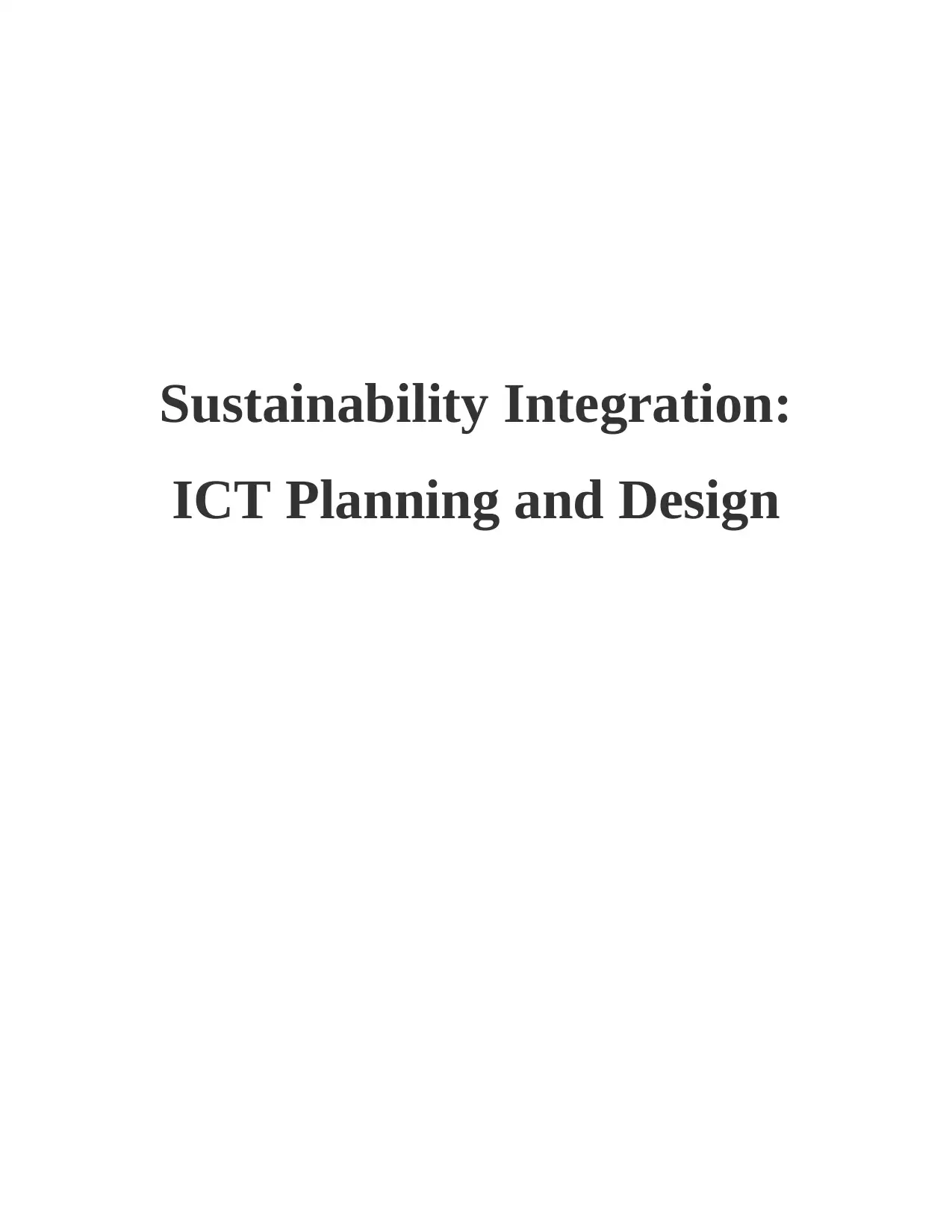
Sustainability Integration:
ICT Planning and Design
ICT Planning and Design
Secure Best Marks with AI Grader
Need help grading? Try our AI Grader for instant feedback on your assignments.
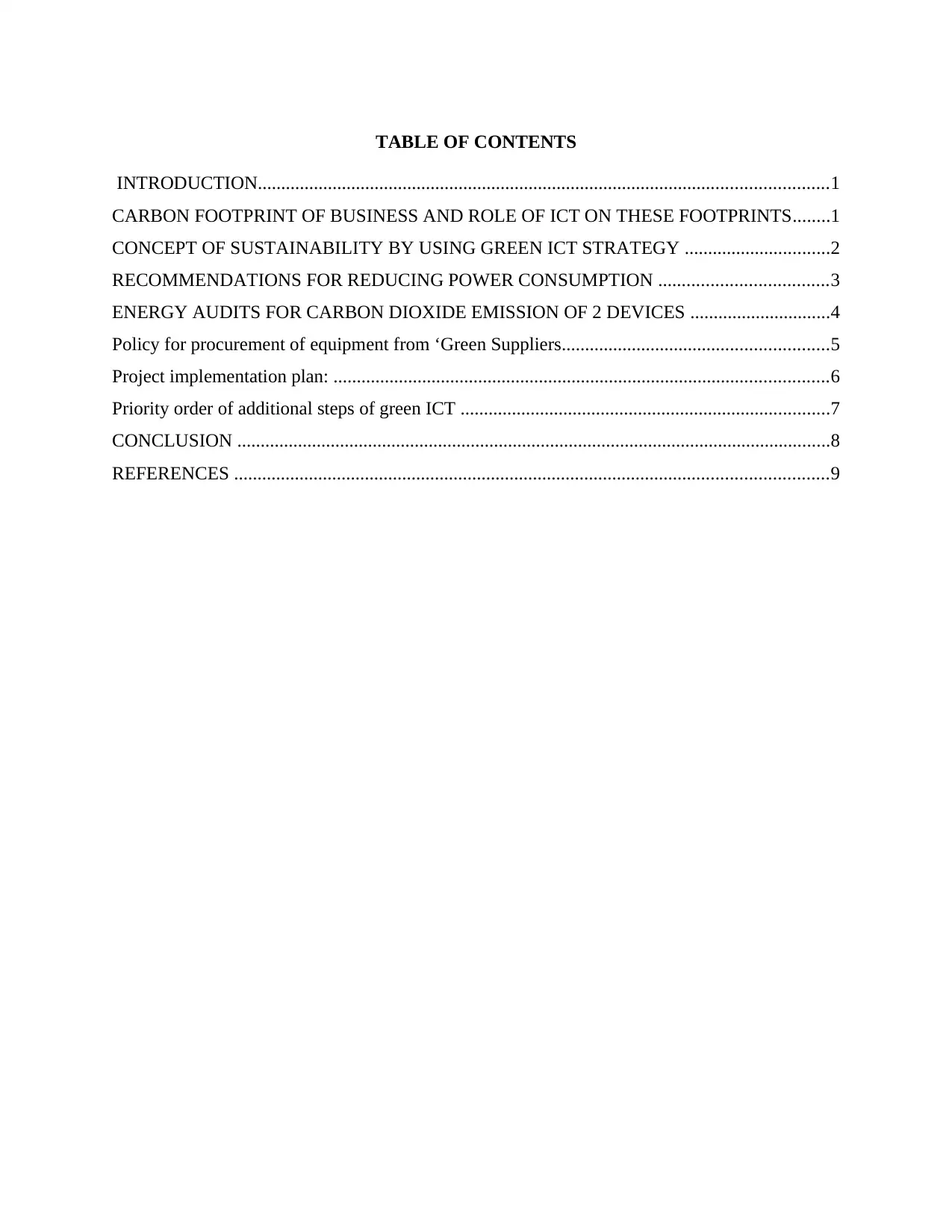
TABLE OF CONTENTS
INTRODUCTION..........................................................................................................................1
CARBON FOOTPRINT OF BUSINESS AND ROLE OF ICT ON THESE FOOTPRINTS........1
CONCEPT OF SUSTAINABILITY BY USING GREEN ICT STRATEGY ...............................2
RECOMMENDATIONS FOR REDUCING POWER CONSUMPTION ....................................3
ENERGY AUDITS FOR CARBON DIOXIDE EMISSION OF 2 DEVICES ..............................4
Policy for procurement of equipment from ‘Green Suppliers.........................................................5
Project implementation plan: ..........................................................................................................6
Priority order of additional steps of green ICT ...............................................................................7
CONCLUSION ...............................................................................................................................8
REFERENCES ...............................................................................................................................9
INTRODUCTION..........................................................................................................................1
CARBON FOOTPRINT OF BUSINESS AND ROLE OF ICT ON THESE FOOTPRINTS........1
CONCEPT OF SUSTAINABILITY BY USING GREEN ICT STRATEGY ...............................2
RECOMMENDATIONS FOR REDUCING POWER CONSUMPTION ....................................3
ENERGY AUDITS FOR CARBON DIOXIDE EMISSION OF 2 DEVICES ..............................4
Policy for procurement of equipment from ‘Green Suppliers.........................................................5
Project implementation plan: ..........................................................................................................6
Priority order of additional steps of green ICT ...............................................................................7
CONCLUSION ...............................................................................................................................8
REFERENCES ...............................................................................................................................9
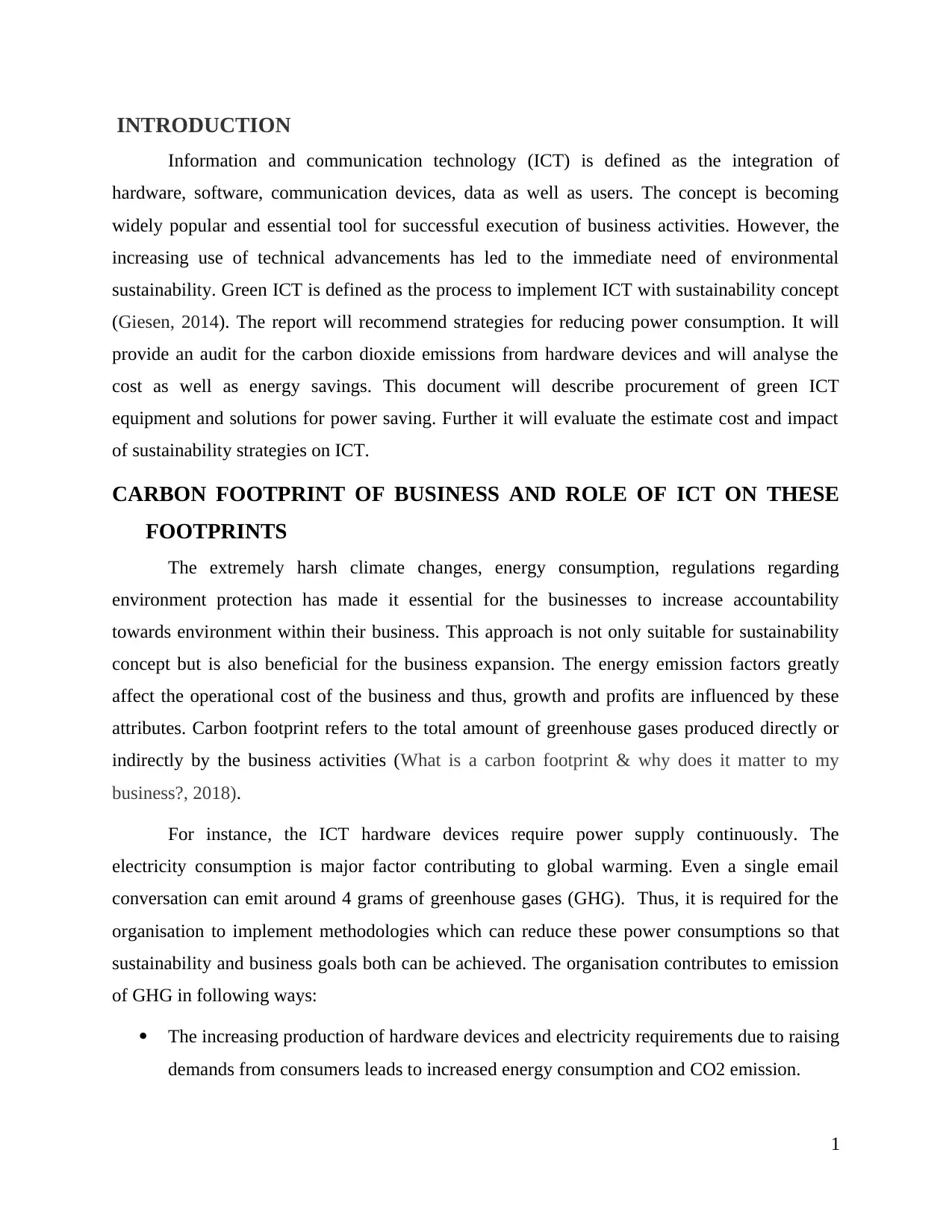
INTRODUCTION
Information and communication technology (ICT) is defined as the integration of
hardware, software, communication devices, data as well as users. The concept is becoming
widely popular and essential tool for successful execution of business activities. However, the
increasing use of technical advancements has led to the immediate need of environmental
sustainability. Green ICT is defined as the process to implement ICT with sustainability concept
(Giesen, 2014). The report will recommend strategies for reducing power consumption. It will
provide an audit for the carbon dioxide emissions from hardware devices and will analyse the
cost as well as energy savings. This document will describe procurement of green ICT
equipment and solutions for power saving. Further it will evaluate the estimate cost and impact
of sustainability strategies on ICT.
CARBON FOOTPRINT OF BUSINESS AND ROLE OF ICT ON THESE
FOOTPRINTS
The extremely harsh climate changes, energy consumption, regulations regarding
environment protection has made it essential for the businesses to increase accountability
towards environment within their business. This approach is not only suitable for sustainability
concept but is also beneficial for the business expansion. The energy emission factors greatly
affect the operational cost of the business and thus, growth and profits are influenced by these
attributes. Carbon footprint refers to the total amount of greenhouse gases produced directly or
indirectly by the business activities (What is a carbon footprint & why does it matter to my
business?, 2018).
For instance, the ICT hardware devices require power supply continuously. The
electricity consumption is major factor contributing to global warming. Even a single email
conversation can emit around 4 grams of greenhouse gases (GHG). Thus, it is required for the
organisation to implement methodologies which can reduce these power consumptions so that
sustainability and business goals both can be achieved. The organisation contributes to emission
of GHG in following ways:
The increasing production of hardware devices and electricity requirements due to raising
demands from consumers leads to increased energy consumption and CO2 emission.
1
Information and communication technology (ICT) is defined as the integration of
hardware, software, communication devices, data as well as users. The concept is becoming
widely popular and essential tool for successful execution of business activities. However, the
increasing use of technical advancements has led to the immediate need of environmental
sustainability. Green ICT is defined as the process to implement ICT with sustainability concept
(Giesen, 2014). The report will recommend strategies for reducing power consumption. It will
provide an audit for the carbon dioxide emissions from hardware devices and will analyse the
cost as well as energy savings. This document will describe procurement of green ICT
equipment and solutions for power saving. Further it will evaluate the estimate cost and impact
of sustainability strategies on ICT.
CARBON FOOTPRINT OF BUSINESS AND ROLE OF ICT ON THESE
FOOTPRINTS
The extremely harsh climate changes, energy consumption, regulations regarding
environment protection has made it essential for the businesses to increase accountability
towards environment within their business. This approach is not only suitable for sustainability
concept but is also beneficial for the business expansion. The energy emission factors greatly
affect the operational cost of the business and thus, growth and profits are influenced by these
attributes. Carbon footprint refers to the total amount of greenhouse gases produced directly or
indirectly by the business activities (What is a carbon footprint & why does it matter to my
business?, 2018).
For instance, the ICT hardware devices require power supply continuously. The
electricity consumption is major factor contributing to global warming. Even a single email
conversation can emit around 4 grams of greenhouse gases (GHG). Thus, it is required for the
organisation to implement methodologies which can reduce these power consumptions so that
sustainability and business goals both can be achieved. The organisation contributes to emission
of GHG in following ways:
The increasing production of hardware devices and electricity requirements due to raising
demands from consumers leads to increased energy consumption and CO2 emission.
1
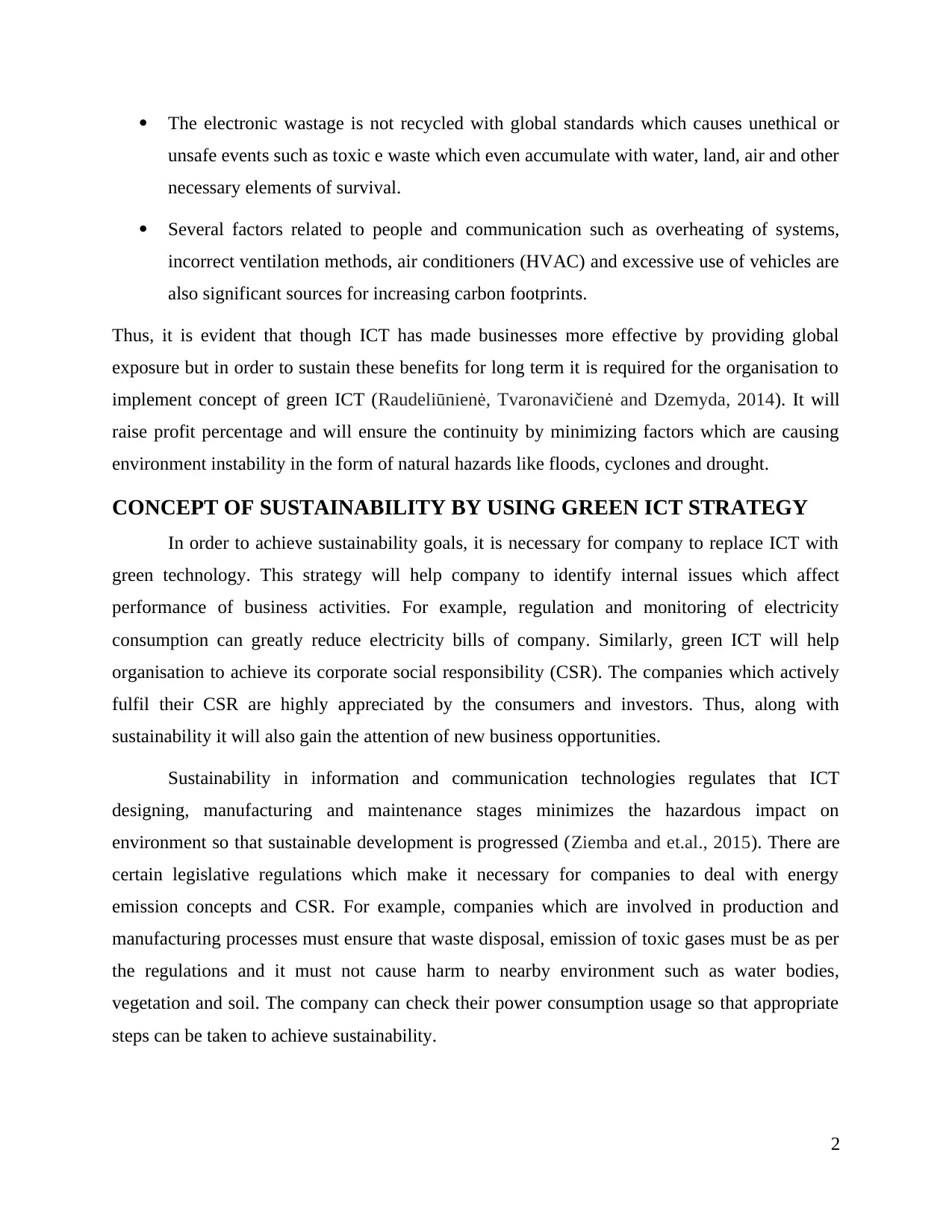
The electronic wastage is not recycled with global standards which causes unethical or
unsafe events such as toxic e waste which even accumulate with water, land, air and other
necessary elements of survival.
Several factors related to people and communication such as overheating of systems,
incorrect ventilation methods, air conditioners (HVAC) and excessive use of vehicles are
also significant sources for increasing carbon footprints.
Thus, it is evident that though ICT has made businesses more effective by providing global
exposure but in order to sustain these benefits for long term it is required for the organisation to
implement concept of green ICT (Raudeliūnienė, Tvaronavičienė and Dzemyda, 2014). It will
raise profit percentage and will ensure the continuity by minimizing factors which are causing
environment instability in the form of natural hazards like floods, cyclones and drought.
CONCEPT OF SUSTAINABILITY BY USING GREEN ICT STRATEGY
In order to achieve sustainability goals, it is necessary for company to replace ICT with
green technology. This strategy will help company to identify internal issues which affect
performance of business activities. For example, regulation and monitoring of electricity
consumption can greatly reduce electricity bills of company. Similarly, green ICT will help
organisation to achieve its corporate social responsibility (CSR). The companies which actively
fulfil their CSR are highly appreciated by the consumers and investors. Thus, along with
sustainability it will also gain the attention of new business opportunities.
Sustainability in information and communication technologies regulates that ICT
designing, manufacturing and maintenance stages minimizes the hazardous impact on
environment so that sustainable development is progressed (Ziemba and et.al., 2015). There are
certain legislative regulations which make it necessary for companies to deal with energy
emission concepts and CSR. For example, companies which are involved in production and
manufacturing processes must ensure that waste disposal, emission of toxic gases must be as per
the regulations and it must not cause harm to nearby environment such as water bodies,
vegetation and soil. The company can check their power consumption usage so that appropriate
steps can be taken to achieve sustainability.
2
unsafe events such as toxic e waste which even accumulate with water, land, air and other
necessary elements of survival.
Several factors related to people and communication such as overheating of systems,
incorrect ventilation methods, air conditioners (HVAC) and excessive use of vehicles are
also significant sources for increasing carbon footprints.
Thus, it is evident that though ICT has made businesses more effective by providing global
exposure but in order to sustain these benefits for long term it is required for the organisation to
implement concept of green ICT (Raudeliūnienė, Tvaronavičienė and Dzemyda, 2014). It will
raise profit percentage and will ensure the continuity by minimizing factors which are causing
environment instability in the form of natural hazards like floods, cyclones and drought.
CONCEPT OF SUSTAINABILITY BY USING GREEN ICT STRATEGY
In order to achieve sustainability goals, it is necessary for company to replace ICT with
green technology. This strategy will help company to identify internal issues which affect
performance of business activities. For example, regulation and monitoring of electricity
consumption can greatly reduce electricity bills of company. Similarly, green ICT will help
organisation to achieve its corporate social responsibility (CSR). The companies which actively
fulfil their CSR are highly appreciated by the consumers and investors. Thus, along with
sustainability it will also gain the attention of new business opportunities.
Sustainability in information and communication technologies regulates that ICT
designing, manufacturing and maintenance stages minimizes the hazardous impact on
environment so that sustainable development is progressed (Ziemba and et.al., 2015). There are
certain legislative regulations which make it necessary for companies to deal with energy
emission concepts and CSR. For example, companies which are involved in production and
manufacturing processes must ensure that waste disposal, emission of toxic gases must be as per
the regulations and it must not cause harm to nearby environment such as water bodies,
vegetation and soil. The company can check their power consumption usage so that appropriate
steps can be taken to achieve sustainability.
2
Secure Best Marks with AI Grader
Need help grading? Try our AI Grader for instant feedback on your assignments.
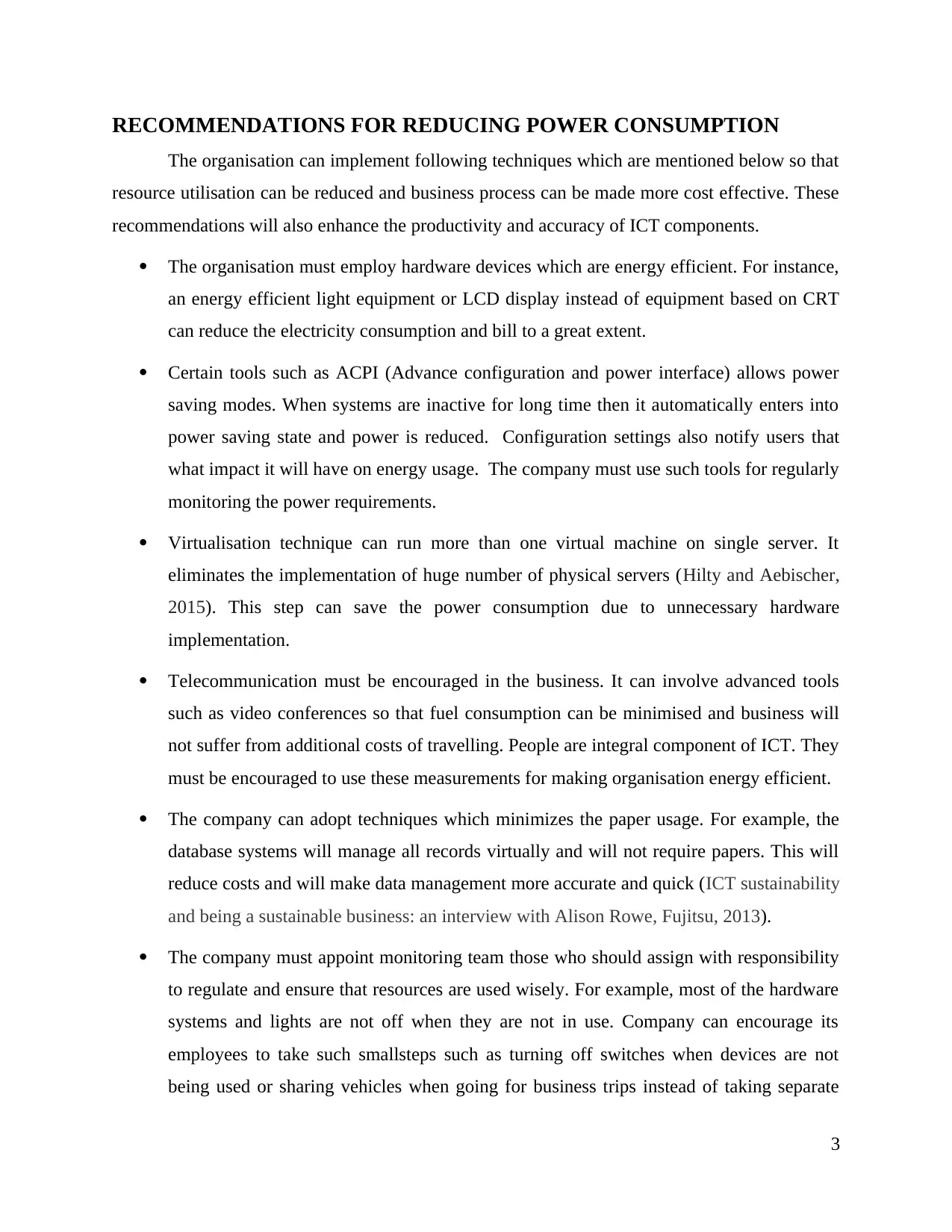
RECOMMENDATIONS FOR REDUCING POWER CONSUMPTION
The organisation can implement following techniques which are mentioned below so that
resource utilisation can be reduced and business process can be made more cost effective. These
recommendations will also enhance the productivity and accuracy of ICT components.
The organisation must employ hardware devices which are energy efficient. For instance,
an energy efficient light equipment or LCD display instead of equipment based on CRT
can reduce the electricity consumption and bill to a great extent.
Certain tools such as ACPI (Advance configuration and power interface) allows power
saving modes. When systems are inactive for long time then it automatically enters into
power saving state and power is reduced. Configuration settings also notify users that
what impact it will have on energy usage. The company must use such tools for regularly
monitoring the power requirements.
Virtualisation technique can run more than one virtual machine on single server. It
eliminates the implementation of huge number of physical servers (Hilty and Aebischer,
2015). This step can save the power consumption due to unnecessary hardware
implementation.
Telecommunication must be encouraged in the business. It can involve advanced tools
such as video conferences so that fuel consumption can be minimised and business will
not suffer from additional costs of travelling. People are integral component of ICT. They
must be encouraged to use these measurements for making organisation energy efficient.
The company can adopt techniques which minimizes the paper usage. For example, the
database systems will manage all records virtually and will not require papers. This will
reduce costs and will make data management more accurate and quick (ICT sustainability
and being a sustainable business: an interview with Alison Rowe, Fujitsu, 2013).
The company must appoint monitoring team those who should assign with responsibility
to regulate and ensure that resources are used wisely. For example, most of the hardware
systems and lights are not off when they are not in use. Company can encourage its
employees to take such smallsteps such as turning off switches when devices are not
being used or sharing vehicles when going for business trips instead of taking separate
3
The organisation can implement following techniques which are mentioned below so that
resource utilisation can be reduced and business process can be made more cost effective. These
recommendations will also enhance the productivity and accuracy of ICT components.
The organisation must employ hardware devices which are energy efficient. For instance,
an energy efficient light equipment or LCD display instead of equipment based on CRT
can reduce the electricity consumption and bill to a great extent.
Certain tools such as ACPI (Advance configuration and power interface) allows power
saving modes. When systems are inactive for long time then it automatically enters into
power saving state and power is reduced. Configuration settings also notify users that
what impact it will have on energy usage. The company must use such tools for regularly
monitoring the power requirements.
Virtualisation technique can run more than one virtual machine on single server. It
eliminates the implementation of huge number of physical servers (Hilty and Aebischer,
2015). This step can save the power consumption due to unnecessary hardware
implementation.
Telecommunication must be encouraged in the business. It can involve advanced tools
such as video conferences so that fuel consumption can be minimised and business will
not suffer from additional costs of travelling. People are integral component of ICT. They
must be encouraged to use these measurements for making organisation energy efficient.
The company can adopt techniques which minimizes the paper usage. For example, the
database systems will manage all records virtually and will not require papers. This will
reduce costs and will make data management more accurate and quick (ICT sustainability
and being a sustainable business: an interview with Alison Rowe, Fujitsu, 2013).
The company must appoint monitoring team those who should assign with responsibility
to regulate and ensure that resources are used wisely. For example, most of the hardware
systems and lights are not off when they are not in use. Company can encourage its
employees to take such smallsteps such as turning off switches when devices are not
being used or sharing vehicles when going for business trips instead of taking separate
3
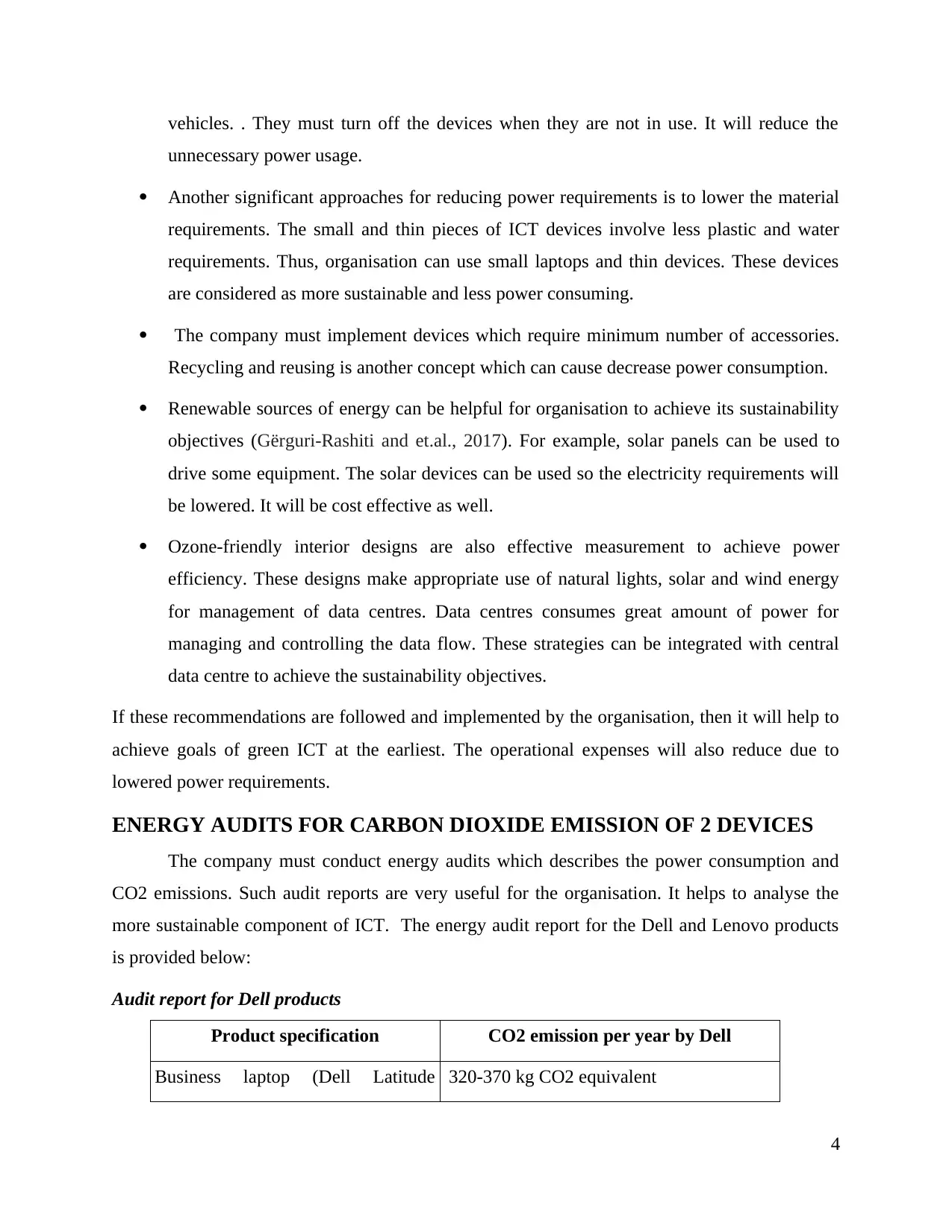
vehicles. . They must turn off the devices when they are not in use. It will reduce the
unnecessary power usage.
Another significant approaches for reducing power requirements is to lower the material
requirements. The small and thin pieces of ICT devices involve less plastic and water
requirements. Thus, organisation can use small laptops and thin devices. These devices
are considered as more sustainable and less power consuming.
The company must implement devices which require minimum number of accessories.
Recycling and reusing is another concept which can cause decrease power consumption.
Renewable sources of energy can be helpful for organisation to achieve its sustainability
objectives (Gërguri‐Rashiti and et.al., 2017). For example, solar panels can be used to
drive some equipment. The solar devices can be used so the electricity requirements will
be lowered. It will be cost effective as well.
Ozone-friendly interior designs are also effective measurement to achieve power
efficiency. These designs make appropriate use of natural lights, solar and wind energy
for management of data centres. Data centres consumes great amount of power for
managing and controlling the data flow. These strategies can be integrated with central
data centre to achieve the sustainability objectives.
If these recommendations are followed and implemented by the organisation, then it will help to
achieve goals of green ICT at the earliest. The operational expenses will also reduce due to
lowered power requirements.
ENERGY AUDITS FOR CARBON DIOXIDE EMISSION OF 2 DEVICES
The company must conduct energy audits which describes the power consumption and
CO2 emissions. Such audit reports are very useful for the organisation. It helps to analyse the
more sustainable component of ICT. The energy audit report for the Dell and Lenovo products
is provided below:
Audit report for Dell products
Product specification CO2 emission per year by Dell
Business laptop (Dell Latitude 320-370 kg CO2 equivalent
4
unnecessary power usage.
Another significant approaches for reducing power requirements is to lower the material
requirements. The small and thin pieces of ICT devices involve less plastic and water
requirements. Thus, organisation can use small laptops and thin devices. These devices
are considered as more sustainable and less power consuming.
The company must implement devices which require minimum number of accessories.
Recycling and reusing is another concept which can cause decrease power consumption.
Renewable sources of energy can be helpful for organisation to achieve its sustainability
objectives (Gërguri‐Rashiti and et.al., 2017). For example, solar panels can be used to
drive some equipment. The solar devices can be used so the electricity requirements will
be lowered. It will be cost effective as well.
Ozone-friendly interior designs are also effective measurement to achieve power
efficiency. These designs make appropriate use of natural lights, solar and wind energy
for management of data centres. Data centres consumes great amount of power for
managing and controlling the data flow. These strategies can be integrated with central
data centre to achieve the sustainability objectives.
If these recommendations are followed and implemented by the organisation, then it will help to
achieve goals of green ICT at the earliest. The operational expenses will also reduce due to
lowered power requirements.
ENERGY AUDITS FOR CARBON DIOXIDE EMISSION OF 2 DEVICES
The company must conduct energy audits which describes the power consumption and
CO2 emissions. Such audit reports are very useful for the organisation. It helps to analyse the
more sustainable component of ICT. The energy audit report for the Dell and Lenovo products
is provided below:
Audit report for Dell products
Product specification CO2 emission per year by Dell
Business laptop (Dell Latitude 320-370 kg CO2 equivalent
4
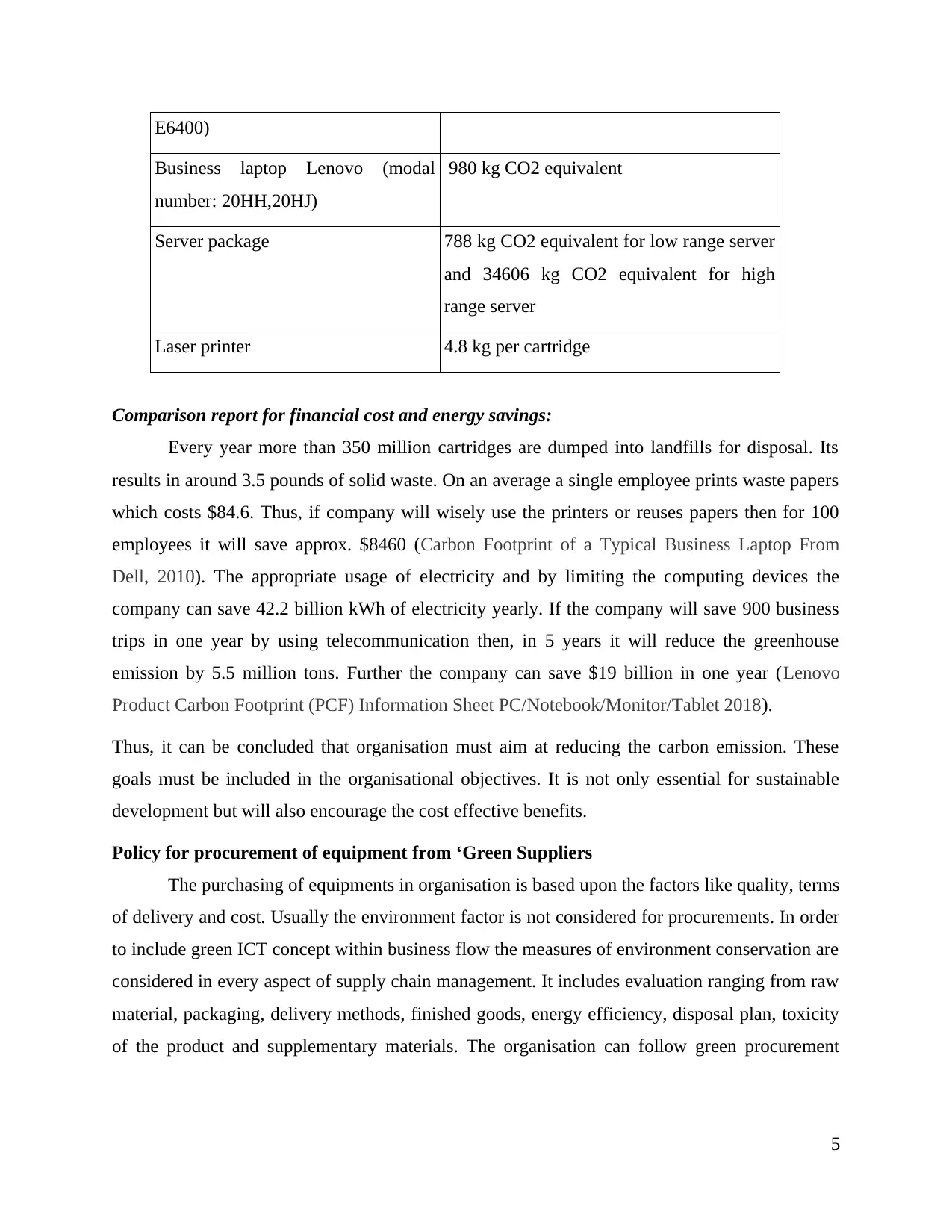
E6400)
Business laptop Lenovo (modal
number: 20HH,20HJ)
980 kg CO2 equivalent
Server package 788 kg CO2 equivalent for low range server
and 34606 kg CO2 equivalent for high
range server
Laser printer 4.8 kg per cartridge
Comparison report for financial cost and energy savings:
Every year more than 350 million cartridges are dumped into landfills for disposal. Its
results in around 3.5 pounds of solid waste. On an average a single employee prints waste papers
which costs $84.6. Thus, if company will wisely use the printers or reuses papers then for 100
employees it will save approx. $8460 (Carbon Footprint of a Typical Business Laptop From
Dell, 2010). The appropriate usage of electricity and by limiting the computing devices the
company can save 42.2 billion kWh of electricity yearly. If the company will save 900 business
trips in one year by using telecommunication then, in 5 years it will reduce the greenhouse
emission by 5.5 million tons. Further the company can save $19 billion in one year (Lenovo
Product Carbon Footprint (PCF) Information Sheet PC/Notebook/Monitor/Tablet 2018).
Thus, it can be concluded that organisation must aim at reducing the carbon emission. These
goals must be included in the organisational objectives. It is not only essential for sustainable
development but will also encourage the cost effective benefits.
Policy for procurement of equipment from ‘Green Suppliers
The purchasing of equipments in organisation is based upon the factors like quality, terms
of delivery and cost. Usually the environment factor is not considered for procurements. In order
to include green ICT concept within business flow the measures of environment conservation are
considered in every aspect of supply chain management. It includes evaluation ranging from raw
material, packaging, delivery methods, finished goods, energy efficiency, disposal plan, toxicity
of the product and supplementary materials. The organisation can follow green procurement
5
Business laptop Lenovo (modal
number: 20HH,20HJ)
980 kg CO2 equivalent
Server package 788 kg CO2 equivalent for low range server
and 34606 kg CO2 equivalent for high
range server
Laser printer 4.8 kg per cartridge
Comparison report for financial cost and energy savings:
Every year more than 350 million cartridges are dumped into landfills for disposal. Its
results in around 3.5 pounds of solid waste. On an average a single employee prints waste papers
which costs $84.6. Thus, if company will wisely use the printers or reuses papers then for 100
employees it will save approx. $8460 (Carbon Footprint of a Typical Business Laptop From
Dell, 2010). The appropriate usage of electricity and by limiting the computing devices the
company can save 42.2 billion kWh of electricity yearly. If the company will save 900 business
trips in one year by using telecommunication then, in 5 years it will reduce the greenhouse
emission by 5.5 million tons. Further the company can save $19 billion in one year (Lenovo
Product Carbon Footprint (PCF) Information Sheet PC/Notebook/Monitor/Tablet 2018).
Thus, it can be concluded that organisation must aim at reducing the carbon emission. These
goals must be included in the organisational objectives. It is not only essential for sustainable
development but will also encourage the cost effective benefits.
Policy for procurement of equipment from ‘Green Suppliers
The purchasing of equipments in organisation is based upon the factors like quality, terms
of delivery and cost. Usually the environment factor is not considered for procurements. In order
to include green ICT concept within business flow the measures of environment conservation are
considered in every aspect of supply chain management. It includes evaluation ranging from raw
material, packaging, delivery methods, finished goods, energy efficiency, disposal plan, toxicity
of the product and supplementary materials. The organisation can follow green procurement
5
Paraphrase This Document
Need a fresh take? Get an instant paraphrase of this document with our AI Paraphraser
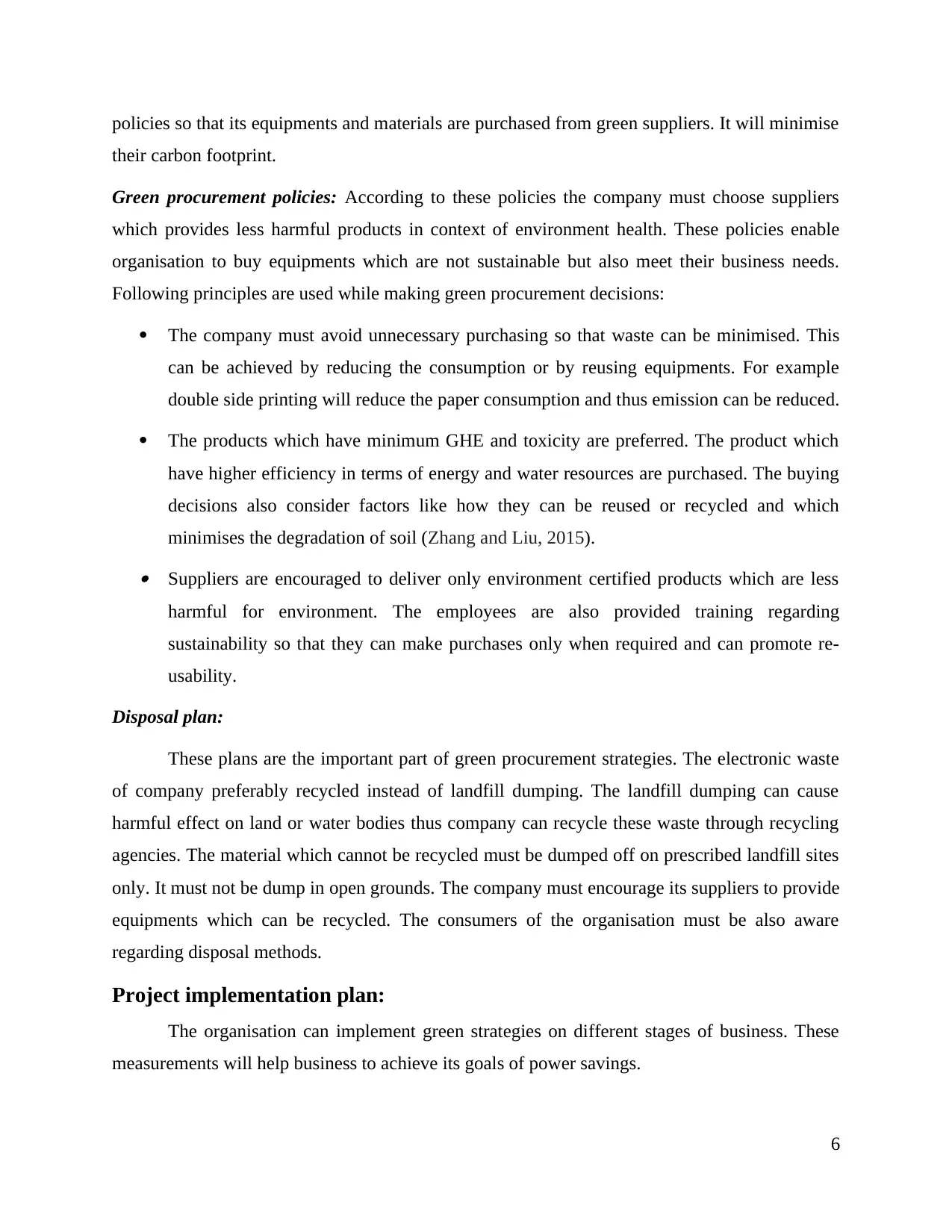
policies so that its equipments and materials are purchased from green suppliers. It will minimise
their carbon footprint.
Green procurement policies: According to these policies the company must choose suppliers
which provides less harmful products in context of environment health. These policies enable
organisation to buy equipments which are not sustainable but also meet their business needs.
Following principles are used while making green procurement decisions:
The company must avoid unnecessary purchasing so that waste can be minimised. This
can be achieved by reducing the consumption or by reusing equipments. For example
double side printing will reduce the paper consumption and thus emission can be reduced.
The products which have minimum GHE and toxicity are preferred. The product which
have higher efficiency in terms of energy and water resources are purchased. The buying
decisions also consider factors like how they can be reused or recycled and which
minimises the degradation of soil (Zhang and Liu, 2015). Suppliers are encouraged to deliver only environment certified products which are less
harmful for environment. The employees are also provided training regarding
sustainability so that they can make purchases only when required and can promote re-
usability.
Disposal plan:
These plans are the important part of green procurement strategies. The electronic waste
of company preferably recycled instead of landfill dumping. The landfill dumping can cause
harmful effect on land or water bodies thus company can recycle these waste through recycling
agencies. The material which cannot be recycled must be dumped off on prescribed landfill sites
only. It must not be dump in open grounds. The company must encourage its suppliers to provide
equipments which can be recycled. The consumers of the organisation must be also aware
regarding disposal methods.
Project implementation plan:
The organisation can implement green strategies on different stages of business. These
measurements will help business to achieve its goals of power savings.
6
their carbon footprint.
Green procurement policies: According to these policies the company must choose suppliers
which provides less harmful products in context of environment health. These policies enable
organisation to buy equipments which are not sustainable but also meet their business needs.
Following principles are used while making green procurement decisions:
The company must avoid unnecessary purchasing so that waste can be minimised. This
can be achieved by reducing the consumption or by reusing equipments. For example
double side printing will reduce the paper consumption and thus emission can be reduced.
The products which have minimum GHE and toxicity are preferred. The product which
have higher efficiency in terms of energy and water resources are purchased. The buying
decisions also consider factors like how they can be reused or recycled and which
minimises the degradation of soil (Zhang and Liu, 2015). Suppliers are encouraged to deliver only environment certified products which are less
harmful for environment. The employees are also provided training regarding
sustainability so that they can make purchases only when required and can promote re-
usability.
Disposal plan:
These plans are the important part of green procurement strategies. The electronic waste
of company preferably recycled instead of landfill dumping. The landfill dumping can cause
harmful effect on land or water bodies thus company can recycle these waste through recycling
agencies. The material which cannot be recycled must be dumped off on prescribed landfill sites
only. It must not be dump in open grounds. The company must encourage its suppliers to provide
equipments which can be recycled. The consumers of the organisation must be also aware
regarding disposal methods.
Project implementation plan:
The organisation can implement green strategies on different stages of business. These
measurements will help business to achieve its goals of power savings.
6
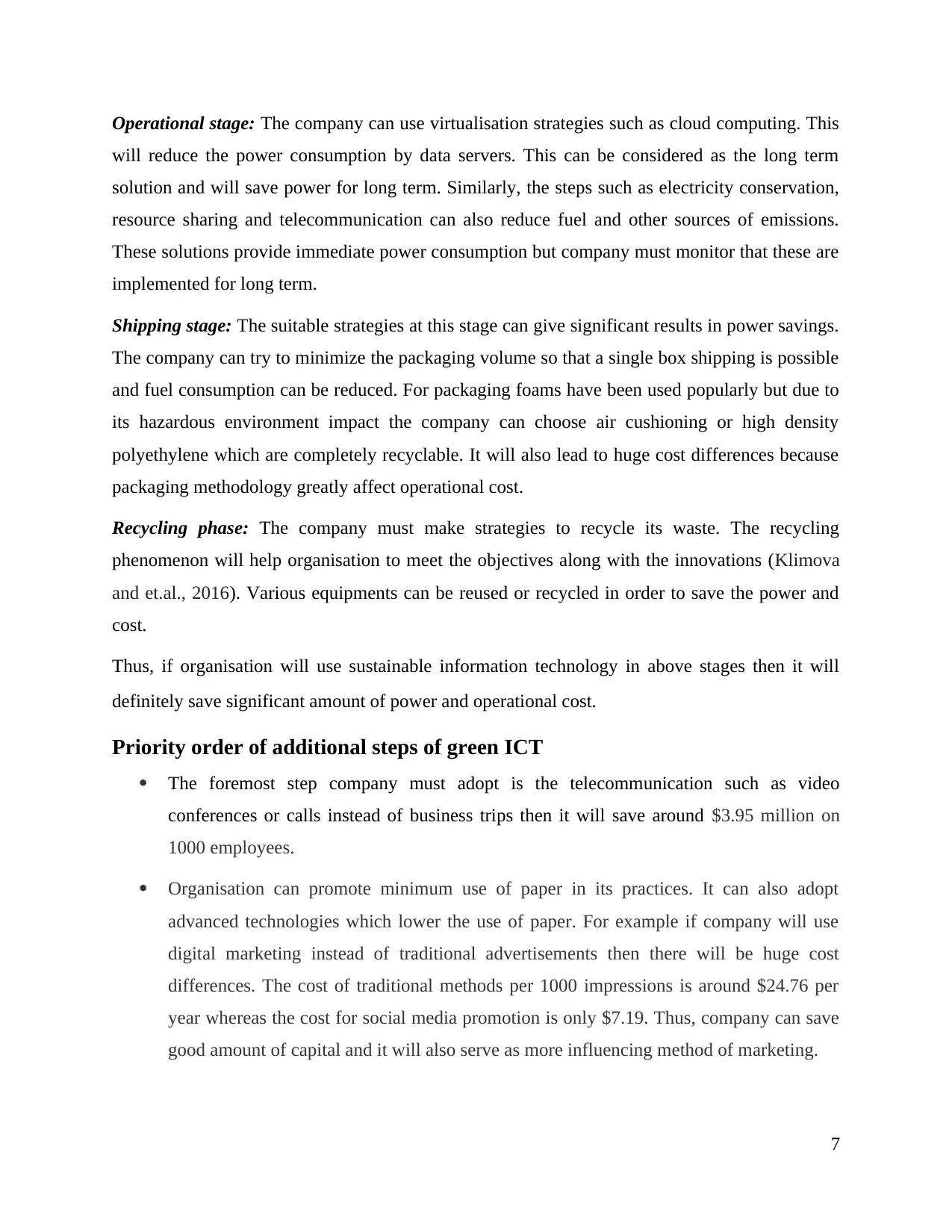
Operational stage: The company can use virtualisation strategies such as cloud computing. This
will reduce the power consumption by data servers. This can be considered as the long term
solution and will save power for long term. Similarly, the steps such as electricity conservation,
resource sharing and telecommunication can also reduce fuel and other sources of emissions.
These solutions provide immediate power consumption but company must monitor that these are
implemented for long term.
Shipping stage: The suitable strategies at this stage can give significant results in power savings.
The company can try to minimize the packaging volume so that a single box shipping is possible
and fuel consumption can be reduced. For packaging foams have been used popularly but due to
its hazardous environment impact the company can choose air cushioning or high density
polyethylene which are completely recyclable. It will also lead to huge cost differences because
packaging methodology greatly affect operational cost.
Recycling phase: The company must make strategies to recycle its waste. The recycling
phenomenon will help organisation to meet the objectives along with the innovations (Klimova
and et.al., 2016). Various equipments can be reused or recycled in order to save the power and
cost.
Thus, if organisation will use sustainable information technology in above stages then it will
definitely save significant amount of power and operational cost.
Priority order of additional steps of green ICT
The foremost step company must adopt is the telecommunication such as video
conferences or calls instead of business trips then it will save around $3.95 million on
1000 employees.
Organisation can promote minimum use of paper in its practices. It can also adopt
advanced technologies which lower the use of paper. For example if company will use
digital marketing instead of traditional advertisements then there will be huge cost
differences. The cost of traditional methods per 1000 impressions is around $24.76 per
year whereas the cost for social media promotion is only $7.19. Thus, company can save
good amount of capital and it will also serve as more influencing method of marketing.
7
will reduce the power consumption by data servers. This can be considered as the long term
solution and will save power for long term. Similarly, the steps such as electricity conservation,
resource sharing and telecommunication can also reduce fuel and other sources of emissions.
These solutions provide immediate power consumption but company must monitor that these are
implemented for long term.
Shipping stage: The suitable strategies at this stage can give significant results in power savings.
The company can try to minimize the packaging volume so that a single box shipping is possible
and fuel consumption can be reduced. For packaging foams have been used popularly but due to
its hazardous environment impact the company can choose air cushioning or high density
polyethylene which are completely recyclable. It will also lead to huge cost differences because
packaging methodology greatly affect operational cost.
Recycling phase: The company must make strategies to recycle its waste. The recycling
phenomenon will help organisation to meet the objectives along with the innovations (Klimova
and et.al., 2016). Various equipments can be reused or recycled in order to save the power and
cost.
Thus, if organisation will use sustainable information technology in above stages then it will
definitely save significant amount of power and operational cost.
Priority order of additional steps of green ICT
The foremost step company must adopt is the telecommunication such as video
conferences or calls instead of business trips then it will save around $3.95 million on
1000 employees.
Organisation can promote minimum use of paper in its practices. It can also adopt
advanced technologies which lower the use of paper. For example if company will use
digital marketing instead of traditional advertisements then there will be huge cost
differences. The cost of traditional methods per 1000 impressions is around $24.76 per
year whereas the cost for social media promotion is only $7.19. Thus, company can save
good amount of capital and it will also serve as more influencing method of marketing.
7
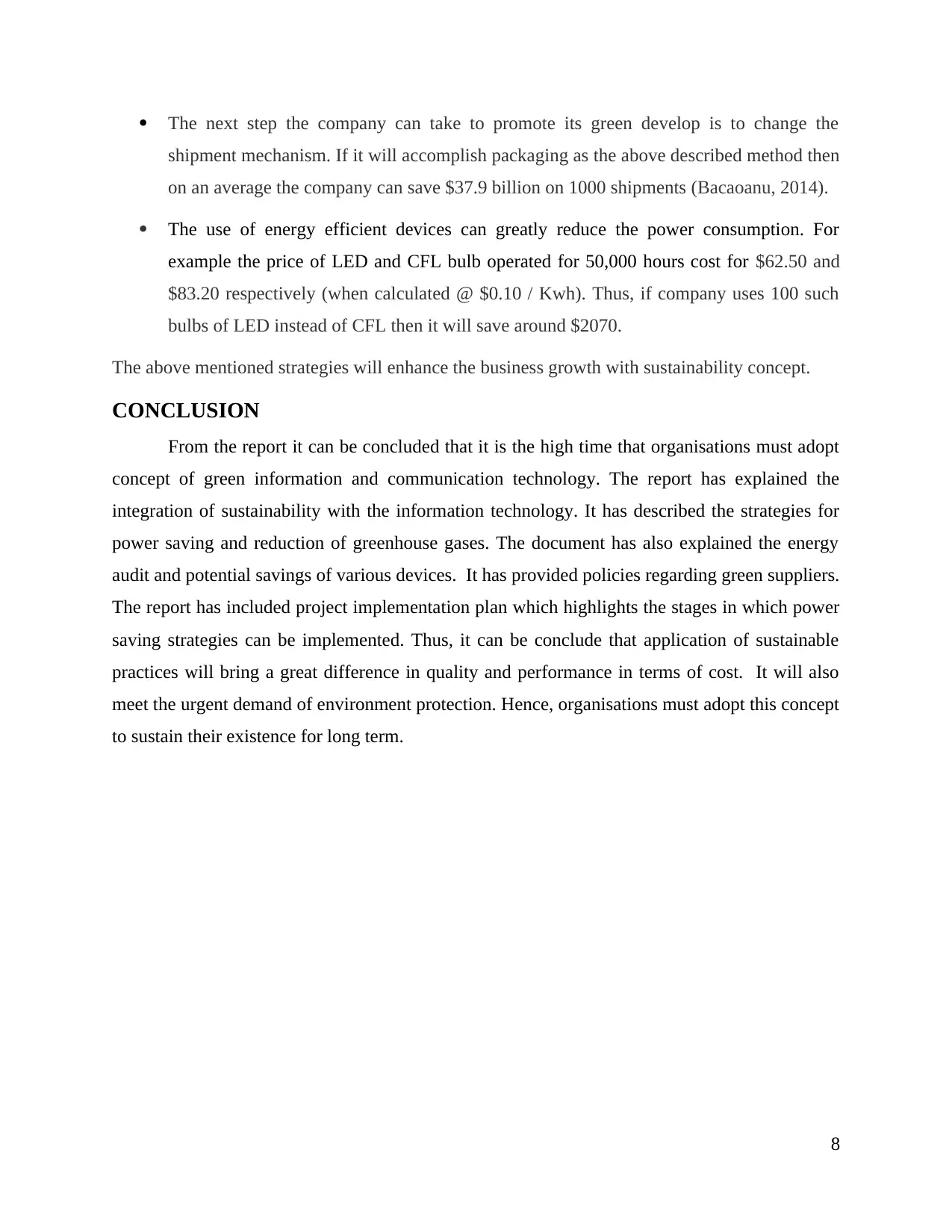
The next step the company can take to promote its green develop is to change the
shipment mechanism. If it will accomplish packaging as the above described method then
on an average the company can save $37.9 billion on 1000 shipments (Bacaoanu, 2014).
The use of energy efficient devices can greatly reduce the power consumption. For
example the price of LED and CFL bulb operated for 50,000 hours cost for $62.50 and
$83.20 respectively (when calculated @ $0.10 / Kwh). Thus, if company uses 100 such
bulbs of LED instead of CFL then it will save around $2070.
The above mentioned strategies will enhance the business growth with sustainability concept.
CONCLUSION
From the report it can be concluded that it is the high time that organisations must adopt
concept of green information and communication technology. The report has explained the
integration of sustainability with the information technology. It has described the strategies for
power saving and reduction of greenhouse gases. The document has also explained the energy
audit and potential savings of various devices. It has provided policies regarding green suppliers.
The report has included project implementation plan which highlights the stages in which power
saving strategies can be implemented. Thus, it can be conclude that application of sustainable
practices will bring a great difference in quality and performance in terms of cost. It will also
meet the urgent demand of environment protection. Hence, organisations must adopt this concept
to sustain their existence for long term.
8
shipment mechanism. If it will accomplish packaging as the above described method then
on an average the company can save $37.9 billion on 1000 shipments (Bacaoanu, 2014).
The use of energy efficient devices can greatly reduce the power consumption. For
example the price of LED and CFL bulb operated for 50,000 hours cost for $62.50 and
$83.20 respectively (when calculated @ $0.10 / Kwh). Thus, if company uses 100 such
bulbs of LED instead of CFL then it will save around $2070.
The above mentioned strategies will enhance the business growth with sustainability concept.
CONCLUSION
From the report it can be concluded that it is the high time that organisations must adopt
concept of green information and communication technology. The report has explained the
integration of sustainability with the information technology. It has described the strategies for
power saving and reduction of greenhouse gases. The document has also explained the energy
audit and potential savings of various devices. It has provided policies regarding green suppliers.
The report has included project implementation plan which highlights the stages in which power
saving strategies can be implemented. Thus, it can be conclude that application of sustainable
practices will bring a great difference in quality and performance in terms of cost. It will also
meet the urgent demand of environment protection. Hence, organisations must adopt this concept
to sustain their existence for long term.
8
Secure Best Marks with AI Grader
Need help grading? Try our AI Grader for instant feedback on your assignments.
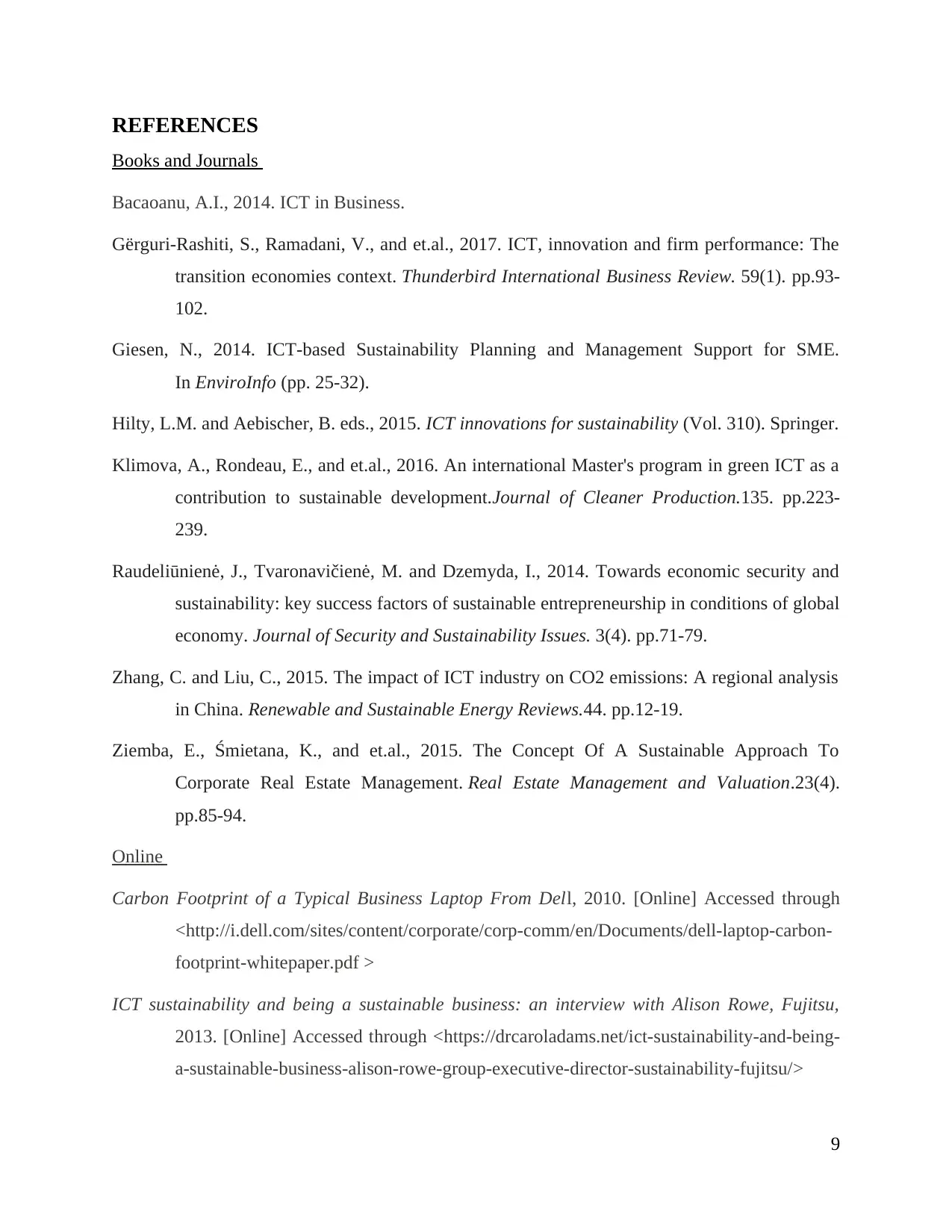
REFERENCES
Books and Journals
Bacaoanu, A.I., 2014. ICT in Business.
Gërguri‐Rashiti, S., Ramadani, V., and et.al., 2017. ICT, innovation and firm performance: The
transition economies context. Thunderbird International Business Review. 59(1). pp.93-
102.
Giesen, N., 2014. ICT-based Sustainability Planning and Management Support for SME.
In EnviroInfo (pp. 25-32).
Hilty, L.M. and Aebischer, B. eds., 2015. ICT innovations for sustainability (Vol. 310). Springer.
Klimova, A., Rondeau, E., and et.al., 2016. An international Master's program in green ICT as a
contribution to sustainable development.Journal of Cleaner Production.135. pp.223-
239.
Raudeliūnienė, J., Tvaronavičienė, M. and Dzemyda, I., 2014. Towards economic security and
sustainability: key success factors of sustainable entrepreneurship in conditions of global
economy. Journal of Security and Sustainability Issues. 3(4). pp.71-79.
Zhang, C. and Liu, C., 2015. The impact of ICT industry on CO2 emissions: A regional analysis
in China. Renewable and Sustainable Energy Reviews.44. pp.12-19.
Ziemba, E., Śmietana, K., and et.al., 2015. The Concept Of A Sustainable Approach To
Corporate Real Estate Management. Real Estate Management and Valuation.23(4).
pp.85-94.
Online
Carbon Footprint of a Typical Business Laptop From Dell, 2010. [Online] Accessed through
<http://i.dell.com/sites/content/corporate/corp-comm/en/Documents/dell-laptop-carbon-
footprint-whitepaper.pdf >
ICT sustainability and being a sustainable business: an interview with Alison Rowe, Fujitsu,
2013. [Online] Accessed through <https://drcaroladams.net/ict-sustainability-and-being-
a-sustainable-business-alison-rowe-group-executive-director-sustainability-fujitsu/>
9
Books and Journals
Bacaoanu, A.I., 2014. ICT in Business.
Gërguri‐Rashiti, S., Ramadani, V., and et.al., 2017. ICT, innovation and firm performance: The
transition economies context. Thunderbird International Business Review. 59(1). pp.93-
102.
Giesen, N., 2014. ICT-based Sustainability Planning and Management Support for SME.
In EnviroInfo (pp. 25-32).
Hilty, L.M. and Aebischer, B. eds., 2015. ICT innovations for sustainability (Vol. 310). Springer.
Klimova, A., Rondeau, E., and et.al., 2016. An international Master's program in green ICT as a
contribution to sustainable development.Journal of Cleaner Production.135. pp.223-
239.
Raudeliūnienė, J., Tvaronavičienė, M. and Dzemyda, I., 2014. Towards economic security and
sustainability: key success factors of sustainable entrepreneurship in conditions of global
economy. Journal of Security and Sustainability Issues. 3(4). pp.71-79.
Zhang, C. and Liu, C., 2015. The impact of ICT industry on CO2 emissions: A regional analysis
in China. Renewable and Sustainable Energy Reviews.44. pp.12-19.
Ziemba, E., Śmietana, K., and et.al., 2015. The Concept Of A Sustainable Approach To
Corporate Real Estate Management. Real Estate Management and Valuation.23(4).
pp.85-94.
Online
Carbon Footprint of a Typical Business Laptop From Dell, 2010. [Online] Accessed through
<http://i.dell.com/sites/content/corporate/corp-comm/en/Documents/dell-laptop-carbon-
footprint-whitepaper.pdf >
ICT sustainability and being a sustainable business: an interview with Alison Rowe, Fujitsu,
2013. [Online] Accessed through <https://drcaroladams.net/ict-sustainability-and-being-
a-sustainable-business-alison-rowe-group-executive-director-sustainability-fujitsu/>
9
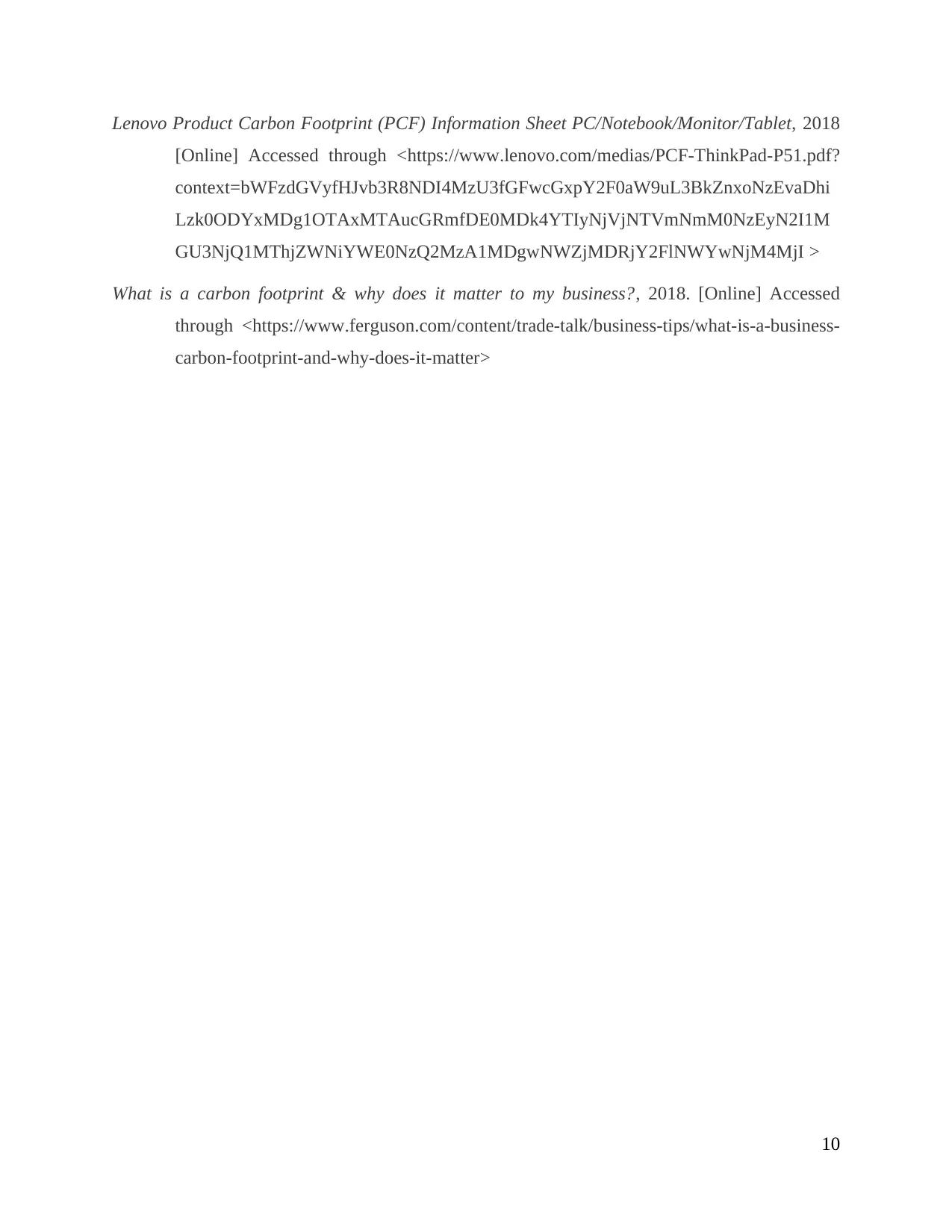
Lenovo Product Carbon Footprint (PCF) Information Sheet PC/Notebook/Monitor/Tablet, 2018
[Online] Accessed through <https://www.lenovo.com/medias/PCF-ThinkPad-P51.pdf?
context=bWFzdGVyfHJvb3R8NDI4MzU3fGFwcGxpY2F0aW9uL3BkZnxoNzEvaDhi
Lzk0ODYxMDg1OTAxMTAucGRmfDE0MDk4YTIyNjVjNTVmNmM0NzEyN2I1M
GU3NjQ1MThjZWNiYWE0NzQ2MzA1MDgwNWZjMDRjY2FlNWYwNjM4MjI >
What is a carbon footprint & why does it matter to my business?, 2018. [Online] Accessed
through <https://www.ferguson.com/content/trade-talk/business-tips/what-is-a-business-
carbon-footprint-and-why-does-it-matter>
10
[Online] Accessed through <https://www.lenovo.com/medias/PCF-ThinkPad-P51.pdf?
context=bWFzdGVyfHJvb3R8NDI4MzU3fGFwcGxpY2F0aW9uL3BkZnxoNzEvaDhi
Lzk0ODYxMDg1OTAxMTAucGRmfDE0MDk4YTIyNjVjNTVmNmM0NzEyN2I1M
GU3NjQ1MThjZWNiYWE0NzQ2MzA1MDgwNWZjMDRjY2FlNWYwNjM4MjI >
What is a carbon footprint & why does it matter to my business?, 2018. [Online] Accessed
through <https://www.ferguson.com/content/trade-talk/business-tips/what-is-a-business-
carbon-footprint-and-why-does-it-matter>
10
1 out of 12
Related Documents
Your All-in-One AI-Powered Toolkit for Academic Success.
+13062052269
info@desklib.com
Available 24*7 on WhatsApp / Email
![[object Object]](/_next/static/media/star-bottom.7253800d.svg)
Unlock your academic potential
© 2024 | Zucol Services PVT LTD | All rights reserved.





